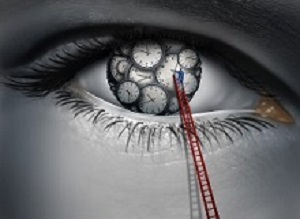 Circadian rhythms, the natural variations in our behaviour and activity throughout a 24-hour period, are known to affect everything from hormones to eating habits. Now, a study led by the University of Glasgow has found that disrupted circadian rhythms are associated with increased risk of mood disorders, including depression and bipolar disorder. Circadian disruption was also associated with lower subjective well-being, higher neuroticism and greater mood instability.
Circadian rhythms, the natural variations in our behaviour and activity throughout a 24-hour period, are known to affect everything from hormones to eating habits. Now, a study led by the University of Glasgow has found that disrupted circadian rhythms are associated with increased risk of mood disorders, including depression and bipolar disorder. Circadian disruption was also associated with lower subjective well-being, higher neuroticism and greater mood instability.
Circadian rhythms are variations in physiology and behaviour that recur every 24-hours, such as the sleep-wake cycle and daily patterns of hormone release. Circadian rhythms occur in plants, animals and throughout biology. They are fundamental for maintaining health in humans, and integrity of circadian rhythms is particularly important for mental health and well-being.
The researchers used activity data on 91,105 participants in the UK Biobank cohort to obtain an objective measure of daily rest-activity rhythms, called relative amplitude. Individuals with lower relative amplitude were at greater risk of several adverse mental health outcomes, even after adjusting for confounding factors, such as age, sex, lifestyle, education and previous childhood trauma.
Dr Laura Lyall, lead author, said: “In the largest such study ever conducted, we found a robust association between disruption of circadian rhythms and mood disorders. Previous studies have identified associations between disrupted circadian rhythms and poor mental health, but these were on relatively small samples.”
In addition to increased risk of depression and bipolar disorder, lower relative amplitude was also associated with low subjective ratings of happiness and health satisfaction, with higher risk of reporting loneliness, and with slower reaction time (an indirect measure of cognitive ability).
A lower circadian amplitude denotes less distinction, in terms of activity levels, between active and rest periods of the day. This can be due to reduced activity during waking periods or increased activity during rest periods. Shifts in energy levels and sleep disturbances are common during clinical depression and episodes of bipolar disorder.
Professor Daniel Smith, professor of psychiatry and senior author, said:“This is an important study demonstrating a robust association between disrupted circadian rhythmicity and mood disorders.
“The next step will be to identify the mechanisms by which genetic and environmental causes of circadian disruption interact to increase an individual’s risk of depression and bipolar disorder.
“This is important globally because more and more people are living in urban environments that are known to increase risk of circadian disruption and, by extension, adverse mental health outcomes.”
The work was funded by a Lister Prize Fellowship to Professor Smith.
Summary
Background: Disruption of sleep and circadian rhythmicity is a core feature of mood disorders and might be associated with increased susceptibility to such disorders. Previous studies in this area have used subjective reports of activity and sleep patterns, but the availability of accelerometer-based data from UK Biobank participants permits the derivation and analysis of new, objectively ascertained circadian rhythmicity parameters. We examined associations between objectively assessed circadian rhythmicity and mental health and wellbeing phenotypes, including lifetime history of mood disorder.
Methods: UK residents aged 37–73 years were recruited into the UK Biobank general population cohort from 2006 to 2010. We used data from a subset of participants whose activity levels were recorded by wearing a wrist-worn accelerometer for 7 days. From these data, we derived a circadian relative amplitude variable, which is a measure of the extent to which circadian rhythmicity of rest–activity cycles is disrupted. In the same sample, we examined cross-sectional associations between low relative amplitude and mood disorder, wellbeing, and cognitive variables using a series of regression models. Our final model adjusted for age and season at the time that accelerometry started, sex, ethnic origin, Townsend deprivation score, smoking status, alcohol intake, educational attainment, overall mean acceleration recorded by accelerometry, body-mass index, and a binary measure of childhood trauma.
Findings: We included 91 105 participants with accelerometery data collected between 2013 and 2015 in our analyses. A one-quintile reduction in relative amplitude was associated with increased risk of lifetime major depressive disorder (odds ratio [OR] 1·06, 95% CI 1·04–1·08) and lifetime bipolar disorder (1·11, 1·03–1·20), as well as with greater mood instability (1·02, 1·01–1·04), higher neuroticism scores (incident rate ratio 1·01, 1·01–1·02), more subjective loneliness (OR 1·09, 1·07–1·11), lower happiness (0·91, 0·90–0·93), lower health satisfaction (0·90, 0·89–0·91), and slower reaction times (linear regression coefficient 1·75, 1·05–2·45). These associations were independent of demographic, lifestyle, education, and overall activity confounders.
Interpretation: Circadian disruption is reliably associated with various adverse mental health and wellbeing outcomes, including major depressive disorder and bipolar disorder. Lower relative amplitude might be linked to increased susceptibility to mood disorders.
Authors
Laura M Lyall, Cathy A Wyse, Nicholas Graham, Amy Ferguson, Donald M Lyall, Breda Cullen, Carlos A Celis Morales, Stephany M Biello, Daniel Mackay, Joey Ward, Rona J Strawbridge, Jason M R Gill, Mark E S Bailey, Jill P Pell, Daniel J Smith
[link url="https://www.gla.ac.uk/news/headline_585356_en.html"]University of Glasgow material[/link]
[link url="https://www.thelancet.com/journals/lanpsy/article/PIIS2215-0366(18)30139-1/fulltext"]The Lancet Psychiatry article summary[/link]
